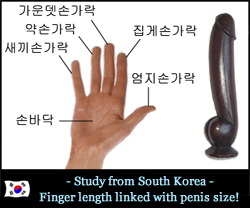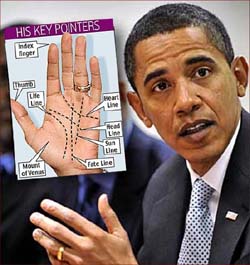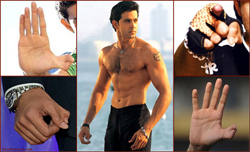‘IN MY HANDS’ – A Marfan syndrome documentary!
May 18, 2011
What did Abraham Lincoln and Johnathan Larson, the playwright of the musical “Rent,” have in common? They both had Marfan Syndrome, according to a new documentary movie that will be screened at the film festival this weekend.
“In My Hands” eloquently explores the lives of a few of the more than 200,000 people in the US stricken with Marfan Syndrome – a little known genetic connective tissue condition that, prior to the invention of open heart surgery in the 1950’s, usually meant a death sentence – and the people who love them.
Dancer and choreographer Ann Reinking, whose son Chris is affected with Marfan syndrome, works with a group of teenagers, designing movement and dance that capitalizes on their shaky long bodies, and unexpectedly, inspires their self-esteem.
 Many syndromes & diseases are features with unusual hand characteristics. Long & hypermobile hands is one of the common characteristics of Marfan Syndrome. Learn a little bit more about Marfan syndrome via this quiz about hand motorics.
Many syndromes & diseases are features with unusual hand characteristics. Long & hypermobile hands is one of the common characteristics of Marfan Syndrome. Learn a little bit more about Marfan syndrome via this quiz about hand motorics.
‘How to win the FIFA World Cup?’ – Football talent is found in finger length of players from Brazil!
June 7, 2010
 
– FINGER LENGTH PREDICTS FOOTBALL ABILITY – [tweetmeme source=”handresearch” only_single=false] Sony Pictures Television International has sold the soccer documentary “How To Win The FIFA World Cup” to a host of international broadcasters. In the documentary new scientific research from The Netherlands (Bernard Krikke, 2010) points out that according DMA-analysis Brazil has the best chance to win the World Cup 2010. Interestingly, the talent of Brazilian football players to become an outperformer was also confirmed by finger length research by British ‘finger professor’ John Manning! WHO WILL WIN THE 2010 FIFIA WORLD CUP? Bernard Krikke + fellow researchers from the University of Groningen analysed 28,400 minutes of football matches including over 250,000 moment from the fields during World Cup games (from 1990 to 2006). According their DMA-analysis (based on: Defense Midfield Attack) Brazil is most likely to win the 2010 tournament, France might become the runner-up, and The Netherlands + Germany are most likely to play for Bronze. The full documentary can be streamed from: RTL’s ‘Wie wint the FIFA WK voetbal’ FINGER LENGTH & FOOTBALL PLAYERS IN BRAZIL! Brazil’s footballing prowess may have more to do with the players’ finger lengths than their training schedule or their ‘hunger’ to succeed, say scientist John Manning from the University of Liverpool. At the 12th Commonwealth International Sport Conference, held in Manchester in the lead-up to the recent Commonwealth Games, Dr John Manning reported on studies suggesting that one simple physical feature offers an accurate means of predicting future footballing ability. It kicks in in the womb and can be seen from birth. In collaboration with colleagues Dr Rogan Taylor and Dr Peter Bundred, John Manning measured the digits of amateur footballers from UK local leagues and professional footballers from the Brazilian first division club Internacional of Porto Alegre. He found a low ratio between the index finger and the ring finger in all the footballers, but the ratio was much lower in the professional players. Kaká’s left hand ‘digit ratio’ appears to be close to 0.90, will be beome the next Brazilian Golden Ball winner? Manning explains in his second book ‘The Finger Book‘ (2008):
“The hands of ninety-nine players were photocopied, of whom thirty-three were members of the senior playing staff. This group of players had an average left-hand finger ratio of 0.93, more masculined than English football’s ‘League Legends’. The first-team squad consisted of twenty players with an even lower average finger ratio of 0.92, and thirteen reserves with a mean ratio of 0.96. Considering the first-team squad, six players had astonishingly low ratios of below 0.90. This group included a forward with a ratio of 0.885, who was subsequently transferred to Barcelona for a fee reported to be in excess of $12 million.” The biggest unanswered question is… who has the Brazilian football player that was transfered to Barcelona for $12M? Anyway, according Manning’s theory Brazilian football player Kaká – who has a digit ratio of close to 0.90 – has a good chance to become the 8th Brazilian winner of the Golden Ball since 1930. A final impressive factual illustration of Brazil’s talent for football: Brazil is the only country that was able to win the Word Cup 5x, but even more impressive… in the history of football only 12 players were able to win the ‘Golden Ball’ when the tournament was not played in the home country of the player – six of those players were Brazilians: Leonidas, Didi, Garrincha, Pelé, Romário & Ronaldo (the list of non-brazilian names is also impressive: Ferenc Puskás, Johan Cruijff, Paolo Rossi, Diego Maradona, Oliver Kahn & Zinedine Zidane). SUGGESTIONS FOR FURTHER READING: |

 “In collaboration with Rogan Taylor and senior coach João Paulo Medina, I was recently fortunate enough to measure the finger ratios of a Brazilian First Division side, Sport Club International of Porto Alegra.”
“In collaboration with Rogan Taylor and senior coach João Paulo Medina, I was recently fortunate enough to measure the finger ratios of a Brazilian First Division side, Sport Club International of Porto Alegra.”

 Finger length & penis size linked!
Finger length & penis size linked! The hands of Barack Obama
The hands of Barack Obama Megan Fox thumbs – TRIBUTE
Megan Fox thumbs – TRIBUTE Hrithik Roshan thumbs – TRIBUTE
Hrithik Roshan thumbs – TRIBUTE Hand Reading Research!
Hand Reading Research! MultiPerspective Palm Reading
MultiPerspective Palm Reading